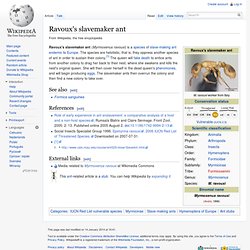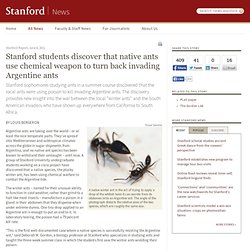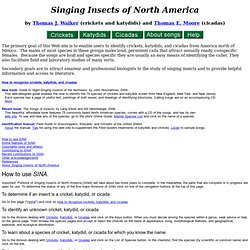

POR CLASIFICAR. Ravoux's slavemaker ant. See also[edit] Formica sanguinea References[edit] External links[edit] Media related to Myrmoxenus ravouxi at Wikimedia Commons.

Unlocking the Secrets of Animal Locomotion. Students discover that native ants use chemical weapon to turn back invading Argentine ants. Trevor Sorrells A native winter ant in the act of trying to apply a drop of the whitish toxin it can secrete from its abdomen onto an Argentine ant.

The angle of the photograph distorts the relative sizes of the two species, which are roughly the same size. Argentine ants are taking over the world – or at least the nice temperate parts. They've spread into Mediterranean and subtropical climates across the globe in sugar shipments from Argentina, and no native ant species has been known to withstand their onslaught – until now. A group of Stanford University undergraduate students working on a class project have discovered that a native species, the plucky winter ant, has been using chemical warfare to combat the Argentine tide. The winter ants – named for their unusual ability to function in cold weather, rather than grind to a halt like most insects – manufacture a poison in a gland in their abdomen that they dispense when under extreme duress.
"I did not believe it at first," she said. Burying beetle. Burying beetles or sexton beetles (genus Nicrophorus) are the best-known members of the family Silphidae (carrion beetles).

Most of these beetles are black with red markings on the elytra (forewings). Burying beetles are true to their name- they bury the carcasses of small vertebrates such as birds and rodents as a food source for their larvae. They are unusual among insects in that both the male and female parents take care of the brood. The American burying beetle (sp. Nicrophorus americanus) has been on the U.S. endangered species list since 1989.[1] Reproduction[edit] Nicrophorus germanicus The carcass must be buried by the beetle(s) to get it out of the way of potential competitors, which are numerous. Burying beetle life cycle The prospective parents begin to dig a hole below the carcass. The adult beetles continue to protect the larvae, which take several days to mature. Species[edit] N. germanicus N. humator N. investigator N. vespillo N. vespilloides N. vestigator Fossils[edit] Robber flies - Asilidae. Common name: robber flies scientific name: Asilidae (Insecta: Diptera: Asilidae) Introduction - Distribution - Description - Biology - Behavior - Key to the Subfamilies of Florida Asilidae - Selected References Introduction (Back to Top) The robber flies are an abundant and diverse family (Asilidae) known for their predatory behavior.
Asilidae diversity can be attributed to their broad distribution, as most species tend to occupy a selective niche. As their common name implies, robber flies have voracious appetites and feed on a vast array of other arthropods, which may help to maintain a healthy balance between insect populations in various habitats (Joern and Rudd 1982, Shurovnekov 1962). Figure 1. Figure 2. Distribution (Back to Top) The Asilidae enjoy a worldwide distribution, with some groups limited to certain regions (Hull 1962). Figure 3. Figure 4. Southern Bee Killer Robber Fly - Mallophora orcina , captured in Brushy Creek, Round Rock, Texas.
Badge creator Use Flickriver Badge Creator to create a badge linking to your photos, your group or any other Flickriver view. You can place your badge on your Flickr profile, Blog or Website. Add to your iGoogle or Netvibes page Flickriver widget for iGoogle or Netvibes can display almost any Flickriver view - most interesting today, by user, by group, by tag etc. Once added to your personalized homepage, just edit widget settings to select your desired view. MYRMECOS - Insect Photography - Insect Pictures. Singing Insects of North America. How to use SINASome features of SINACopyrights (ours and others)Contributing to SINARecent contributions to SINAOther acknowledgementsReferencesAbout Singing Insects of North America How to use SINA.

Important: Portions of Singing Insects of North America [SINA] will take about two more years to complete. In the meanwhile, the parts that are complete or in progress are open for use. To determine the status of any of the five major divisions of SINA click on one of the navigation buttons at the top of this page. To determine if an insect is a cricket, katydid, or cicada Go to this page ("Home") and click on How to recognize crickets, katydids, and cicadas. To identify an unknown cricket, katydid, or cicada Go to the division dealing with Crickets, Katydids, or Cicadas and click on the Keys button. To learn about a species of cricket, katydid, or cicada for which you know the name Go to the division dealing with Crickets, Katydids, or Cicadas and click on the List of Species button.
Image views. Welcome to BugGuide.Net! Bug Review. The Ant Room.